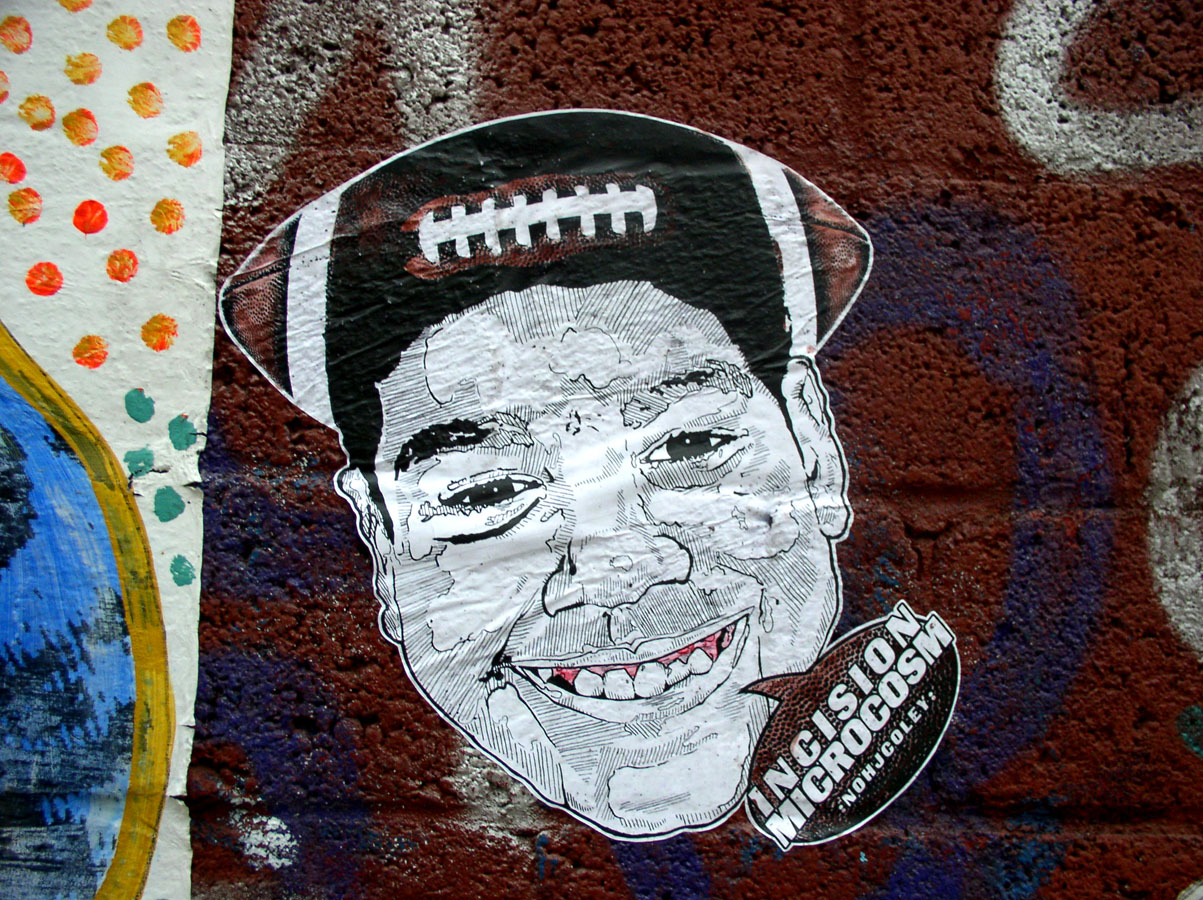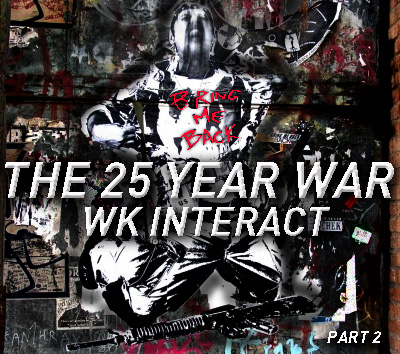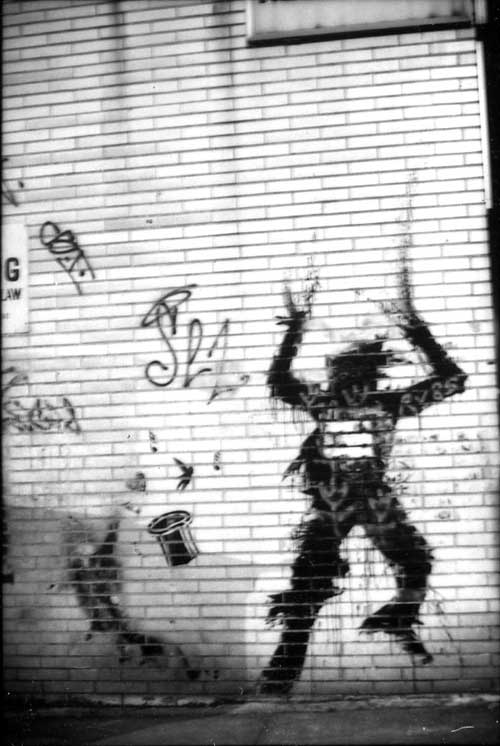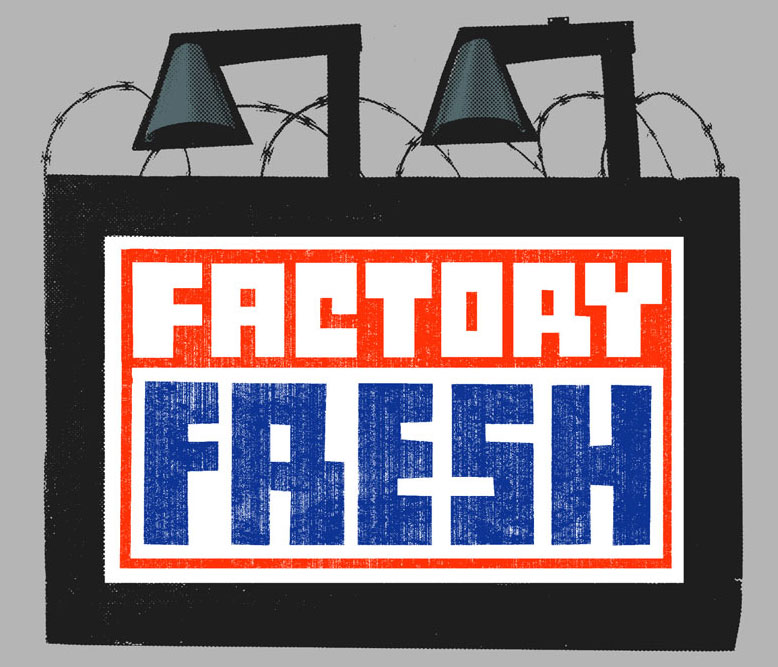A talented Street Artist Schools BSA about his work.
“Good readers make good writers”.
Truey trueness truthfully told by my true-friend Jodi. Which is why one summer I read a stack of Jimmy Peabody’s Mad magazines that he kept hidden under his bed, along with a few dog-eared copies of Penthouse and Playboy. See what all that reading did for me? I write on a blog for 17 readers and my mom. Once somebody taps into the creative spirit, there are no limits to where it will take them.

Three of his biggest influences hover over NohJColey while he works; Dali, Basquiat, and Time (photo Steven P. Harrington)
You can take that advice any way you want, but thinking about the path that NohJColey has taken, it’s ringing true.
NohJColey wants to be a great something. He just winces at every label you offer up, but don’t be put off by it. We’ll be very bold and say “Artist”. He’s been a graffiti artist, a street artist, and a fine artist. To become a great artist, he practices self-education and discipline. With an agile mind and inquisitive nature, he does a great deal of due-diligence; history, background, planning, experimentation and practicing of technique. Then he starts the piece, frequently a personal story or a social commentary of some kind.

A recent Ebay shopping trip netted a selection of vintage artist technique books. (photo Steven P. Harrington)
In fact, so much goes on inside NohJ’s head in the preparation of his work that a viewer may never completely appreciate the final product. That’s okay, he may not intend it to be understood either. He doesn’t lose too much sleep over it, either way. He stays up all night working at a kitchen table with a picture of Salvador Dali and one of Jean-Michel Basquiat on the wall staring down on him, but be assured that he’s not worrying. He’s just working.

“Kutztown’s Favorite” by Nohj Coley (photo Nohj Coley)
“Kutztown’s Favorite” was the first image BSA posted on the “Images of the Week” feature. Not that big a deal for you, I’m sure. If it was a big deal for you, I would worry. But when I consider that image I think about why BSA loves street art; at it’s best it is a celebration of the creative spirit, wherever you can access it. It seems unlimited.
In this case it was a tribute to Keith Haring, an artist who was doing what could later be classified “Street Art” in NYC in the ’80s. The creative spirit that Haring had tapped into 25 years earlier was like a radio frequency or satellite transmission from the creative gods – Haring tapped into it and ran with it, not consulting with experts, anointed, self-proclaimed or otherwise. To see that somebody was doing a street tribute in a distinctly different style all these years later was very notable.
You don’t have to totally understand NohJ’s work to appreciate it, and that’s a good thing because it may take some studying at Noh J High School to get it. Some times you have to go slow for certain students, so BSA recently took some summer remedial classes with Professor Coley in the studio. August was dragging on outside the window and other kids were playing on the jungle gym, but in school, between the endless chain of cigarettes and the loud air conditioner and the louder Thelonius Munk and Charlie Parker, we think it was completely Edutaining.

NohJColey in his home studio. (photo Steven P. Harrington)
Buddies called him “Stiffy” when he was out doing teen rollerblader tricks because NohJ didn’t do diamondz. For that matter he wasn’t even smooth. But he defends his skills as an aggressive rollerblader, “I was a pretty good skater, though. Learning how to fall, that’s the key to skating. But I didn’t have the moves. It’s hard to worry about style when you don’t want to die! I would get hurt sometimes badly. Those days are over”. Lesson learned.
He used to be a graff writer too, hanging out with the 333 Crew, and his tag was Motive for a while. In the mid-1990s he raced from high school in the afternoon to hang out at the Phun Factory, an aerosol Mecca in Queens for graffiti writers run by a guy named Pat DiLillo, who had worked out a deal with the landlord to let graffiti artists go wild on the walls and practice and teach without fear of breaking the law. Pat had been a professional graffiti buffer until he fell in love with talented work and became a huge proponent, clearing the way for what eventually became 5 Pointz, directed by Meres.
Pat even got NohJ into a show at P.S.1 in 1999 with people whose skills he admired – “It was Iz the Wiz, I’m pretty sure it was Elite, Slam4, Spec, and me. The real piecers were of course IZ, Bisc, and Elite. I was Motive 333 – I didn’t actually go to the show. We were sitting across the street ”

“Egalitarian Quench”, Oil pastel, stencil, painters tape and acrylic paint on paper pasted on discarded lumber, by NohJColey (photo Steven P. Harrington)
He’s not thinking that he has the graff thing licked, but he’s moving on to other things these days. Some people are calling it street art. His linotype prints are usually portraits of people he has known or studied about and his text stickers have puzzling word combinations and phrases.
Brooklyn Street Art: So what’s important to you?
NohJColey: Accomplishing stuff. Not being swayed by others’ opinions. Being original. Being true to myself. Family is important, learning is important. Everything is kind of important. Fashion isn’t important
Brooklyn Street Art: Politics?
NohJColey: Of course, that has to be important.
Brooklyn Street Art: Music?
NohJColey: Yeah of course, that is really important.
Brooklyn Street Art: Basquiat?
NohJColey: Yeah he was important to me at some time but not really anymore.
Brooklyn Street Art: Why was he important before?
NohJColey: Probably just because of his lifestyle. He kind of lived precariously. The way he spoke to people.

Basquiat at 19 years (a still from the movie “Downtown 81”)
The choices of words for NohJ’s stickers are directly influenced by another artist of the late ‘70s and early ‘80s who transferred his graff writing directly into his fine arts canvasses, Jean-Michel Basquiat. Writing on the street as SAMO, Basquiat created stuff that looked like pointed non-sequitors, or abbreviated observations that confused and attracted fans.
“I think he always will be important to me just because of the things he wrote like ‘Plush Safe He Think’, or ‘Jimmy Best on his back to the suckerpunch of the world’ (some sources report it was actually Jimmy Best/ On his back/ To the suckerpunch/ Of his childhood files) – stuff like that is the reason I do stickers because it’s a way of basically saying your piece and not having to listen to what anyone else’s input is on the subject. You can basically tell everyone without actually having to tell people individually. Like stopping people and saying ‘You’re a closet racist’.”

NohJ’s sticker text is strongly influenced by the writing style of Brooklyn-born Basquiat. This is a recently released image of Jean-Michel Basquiat by photographer Lee Jaffe.
What? Okay, now I think I get it. These cryptic stickers are a sublimation of true feelings and opinions that NohJ understands, but the reader may not.
Brooklyn Street Art: So it’s a direct-indirect way of addressing issues?
NohJColey: Yep. Even though it’s bad because it isn’t as personal as I would like it to be, but…

The image came from a sketch of his nephew (photo Jaime Rojo)
Brooklyn Street Art: So, about that text that you put on stickers, can you describe a little bit about how you arrive at the choices?
NohJColey: Like I did a sticker that said, “Adolescent Racists Present Parental Perspectives” – Basically it refers to young kids that I see around who are racist because of their parents. It’s not something natural. It has nothing to do with the kid’s choice but if you go into their household he’s going to hear certain terms and attitudes. People just get labels. Like somebody talking about Mexicans, and a Mexican woman who has seven children, and then they talk about whether the health care system should support them; and it’s like, you don’t even know this person, you know? This person actually owns a restaurant and they came here with nothing in their pockets. And her husband actually went to a prestigious college and had a high GPA. And people are judging a book by its cover.

On the wall, one of NohJ’s earlier fine art pieces, “Children of the Wrong” (photo Steven P. Harrington)
NohJ talks about another sticker, “ ‘Observe Hands’ is different – it’s about reading someone’s mind. Like looking at someone’s hands in conversation. And noticing their reactions like picking their nail could be an indication that someone is nervous. Or like someone rubbing their leg, could mean they are bored, or not interested in what they are doing right now.”
The individual pieces that NohJColey creates on large linoleum blocks are surrealist applications of recognizable components into realist line-drawn portraiture. The components can be literal or metaphorical, and always autobiographical. The piece is usually has a murky title that perplexes in the same way as the sticker text. When the linoleum piece isn’t enough, NohJ combines painstaking lace-like geometric cutouts arranged on top of or beside them.

The original plate of Sace (photo Steven P. Harrington)
Brooklyn Street Art: So can you talk about the series that you’ve begun, that started with an image of Dash Snow?
NohJColey: Yeah it’s the “Sprayed in Stone” series. I’m basically just trying to solidify these graffiti writers names a bit more. After someone passes everyone mourns because this person’s gone, and everyone forgets about it. Like maybe a few times a year someone might look at their photograph but it’s not the same as actually seeing this person like proportionally. Like you can walk up to this piece, the Dash Snow piece, and it’s pretty much the same size (as he was). I never met him but I’m guess that he was that size. It’s kind of a little larger because I wanted him to be more prominent. That’s kind of what it’s about. You never really know what a graffiti artist looks like so that is another reason why I wanted to do a portrait of him. A person passes away and you are not given another chance to see them at the same size that they were.

A detail of NohJ Coley shows limbs made of a paint roller, markers, ladders, cans, etc. (photo Jaime Rojo)
Brooklyn Street Art: And yet you render the figure with non-human limbs and other elements, so you are not really bringing back a true replica of the person. Where did those come from?
NohJColey: The spray can of course was a tool he would use, and the markers as well. The fire-extinguisher shirt – you know like a like a lot of graffiti writers use fire extinguishers to do enormous tags on sides of buildings. I guess they are just things he would use as a graffiti artist. Like the spray can coming from his neck.
Brooklyn Street Art: Yeah it’s surrealistic. And this is the first of the series of three?
NohJColey: It’ll be three. The problem with this series is that I’m not able to take photographs of the artist, which to me really hinders the work – because it would be a way better piece. I don’t even like to work from someone else’s eye but they passed on so I’ve gotta use what there is.
Brooklyn Street Art: Right, you didn’t actually have a picture of Dash Snow?
NohJColey: No I didn’t. I used someone’s picture.

NohJ created an amalgam of images first before drawing the Tie One image on the linoleum block. (photo Steven P. Harrington)
Brooklyn Street Art: And who’s next in line in the series?
NohJColey: It’s Jonathan See Lim AKA Tie One

NohJ Coley Detail
Brooklyn Street Art: So tell me about Tie One.
NohJColey: Yeah he was from San Francisco. He was shot in the Tenderloin by William Porter. And he was basically climbing up on the roof. He went there to do a graffiti spot on St. Patrick’s Day. It’s kind of also like – I don’t really want to shed too much light on a graffiti artist faults in life. Whether he was vandalizing, even though that’s what graffiti is…I know that. It’s more about the strides in this persons’ life that he took. Like Tie was 18 when he passed away. And Iz The Wiz, who is the third person in the series, he was like the king of the trains, you know.

The ink is still wet on this just finished 3rd installment in the “Sprayed In Stone” series, Iz the Wiz, by NohJColey
Brooklyn Street Art: Did you ever hang out with Iz the Wiz?
NohJColey: No I never got a chance to meet him but I remember Pat DeLilo telling me a bunch of stories about him. Iz was always sick even in those days when I was hanging out there. Wow, ten years. That’s why I’m glad I did that show with him when I was young.

The original study for “Nothing=Obtained” by NohJColey
Brooklyn Street Art: What about the final work of “Nothing=Obtained” – how did you get that? Can you talk about your process? How did you get that multi-armed creature?
NohJColey: Basically I just had my ex-girlfriend pose. This one I just saw before I did it. I already knew what I was going to do. It was just basically figuring a way in which to place each arm so it sort of made sense.

NohJColey (photo Jaime Rojo)
Brooklyn Street Art: Does the placement of the arms indicate something about her personality?
NohJColey: Well when she walks in a room you pretty much feel her presence. She’s kind of like pulling her head back like she’s stressed out. The mouth is like she’s in awe, her eyes are open because she’s just noticing a bunch of opportunities and then like her grabbing herself because of stress. And this one is her bracing herself.
Brooklyn Street Art: And the words “Nothing = Obtained”?
NohJColey: She never accomplishes the goal, you know? She never gets to the end result. Everything is always left open. There is no conclusion. Like nothing is ever obtained. Like she says she’s trying to change that but it’s not really evident to me. But whatever.

(photo Jaime Rojo)
Brooklyn Street Art: You did another piece last year that was about a cousin of yours?
NohJColey: “Uncondition(al) Solace”?
Brooklyn Street Art: Huh?
NohJColey: Like I try to separate letters sometimes, so you can use the letters different ways.
Brooklyn Street Art: Okay so tell me the story behind that one. You told me about her going into a hospital room to see your aunt.
NohJColey: That piece is about a cousin of mine – I went to see her mother, my aunt, because she had a stroke. And like the right side of her body is paralyzed. To see a person go from walking through a doorway to rolling through a doorway on a stretcher is bad. She doesn’t really react to anything except to her daughter, my cousin. And the piece is her holding up a banner that says “Solace” because I feel like once she walked into the room, my aunt lit up. My cousin is the only one that puts a smile on her face. So that is why I made the piece so that my aunt can look at her daughter whenever she’s awake.
Brooklyn Street Art: You are making your stuff on paper and wheat paste, which means it disappears in about five rainstorms. Then it’s gone, but you put a lot of work into it.
NohJColey: Yeah it’s ephemeral. That’s a good thing about it. It has a life of it’s own and you can’t control it. That’s another reason I like it. You can’t control it. You put it out there and it’s free, you don’t have a leash on it, like a pet.


 BROOKLYN STREET ART LOVES YOU MORE EVERY DAY
BROOKLYN STREET ART LOVES YOU MORE EVERY DAY





























































